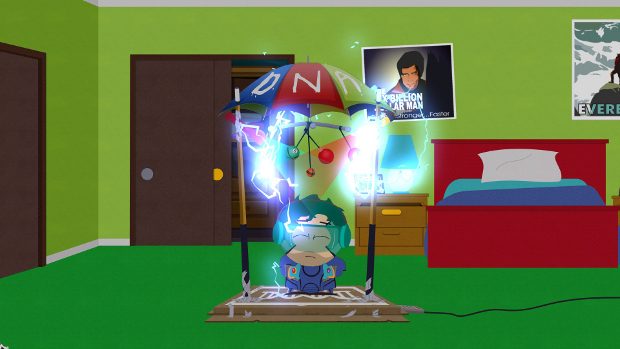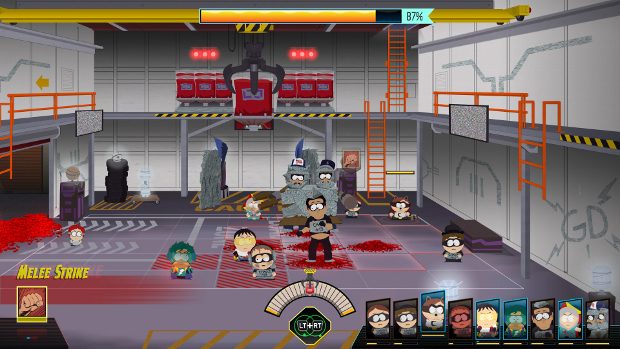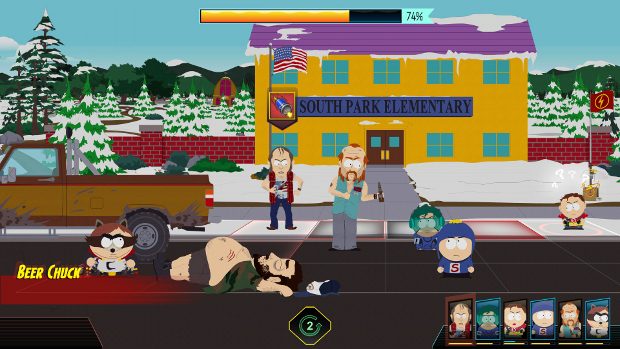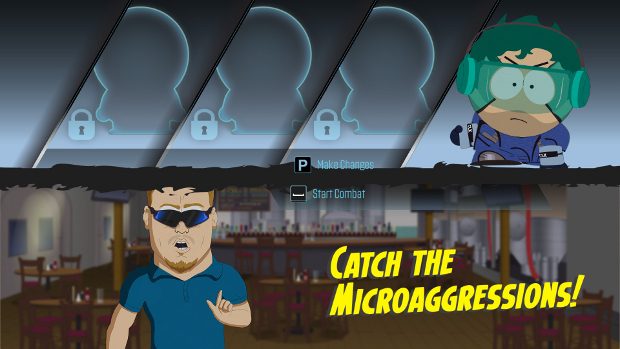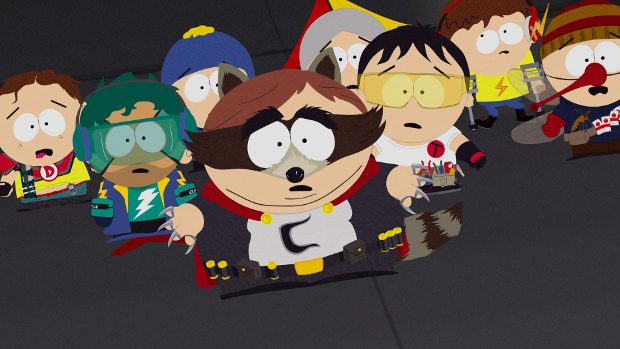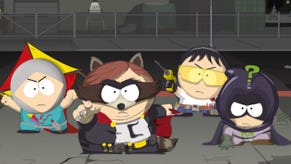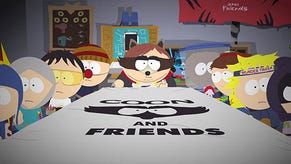Wot I Think - South Park: The Fractured But Whole
Uncivil War
South Park: The Fractured But Whole [official site] is essentially the show’s greatest hits, with 20 years worth of call backs, characters and gags, all built around a LARP-inspired RPG that sees the town’s foul-mouthed kids beating the snot out of each other. If this sounds extremely familiar, that’s because I’ve also just described its predecessor, The Stick of Truth.
Crab People, magical farts, obsessively collecting social media pals, Morgan Freeman -- they are all back. Only the switch from wizards and Elves to superheroes, something that could have been a superficial change, manages to keep it from feeling like watching a repeat.
The Fractured But Whole picks up right after The Stick of Truth, with Cartman putting an end to the fantasy LARP so the neighbourhood kids can start working on the much more important business of solving South Park's crime problems and working on their superhero franchise of movies, cartoons and Netflix series. That Marvel money is tempting stuff.
Once again, we’re put in the shoes of the New Kid, the mute Chosen One and super-powered farter from the previous game, and now the newest member of "Coon and Friends", the town’s premier superhero team.
Instead of picking a class and sticking with it, superheroes are defined by their origins, and thus much of the game is spent crafting an identity for your hero’s character sheet. First, though, there’s a powerset to pick, and a costume to create, though the latter is an entirely aesthetic decisions that you'll undoubtedly change over and over again as you discover new costume parts, from exposed brains to Iron Man armour.
A powerset gives you four themed abilities, three regular ones and a fourth super-charged ultimate that you can only use once your ultimate bar has been filled by successfully pulling off some light QTEs when you’re attacking or defending. Like The Stick of Truth, the trick to winning fights is using attacks enemies are weak to, giving them negative status effects like shocked, bleeding or grossed out.
The change from JRPG battles to turn-based tactical brawls on a grid, however, adds an additional and welcome layer of complexity by making positioning and control of the battlefield important. Say you have a punch that can knock enemies back. To get the full use out of it, you’ll want to knock them into something. If it’s one of your allies -- you’ll usually have a team of four, but that number often increases or decreases for narrative reasons -- they’ll hit your foe when they bump into them. If it’s another enemy, they’ll take damage as well.
Abilities also come in different shapes and ranges. Some can only be used against enemies on a square right next to your hero, others might only work if you’ve got two squares between you and your enemy, so you can charge them, while some have large areas of effect. So a lot of the time, you won’t be able to pull off an attack unless you force enemies to move, pushing them back or sucking them towards you by using another ability.
Four abilities doesn’t give you much to play with, but then you’ll also have all of your superhero pals adding their own powersets to your list of attacks, so you’re able to create combos and craft plans that take advantage of different styles. As the Coon, Cartman can leap around the battlefield, slicing up enemies and leaving them a bleeding mess. Kyle, The Human Kite, on the other hand, can shoot burning lasers out of his eyes, but he’s best at supporting the team by healing and defending them with his kite.
Eventually you’ll be able to, in comic book tradition, retcon your origin (complete with hilarious origin stories told by Cartman) and gain new powers, so you can change your loadout depending on who you’re about to fight. Once you start getting new powers, that’s when the limit of four begins to feel a little stifling, but a lot of that is down to the fact that they’re all so fun to play with.
Like its predecessor’s, combat in The Fractured But Whole seems slight at first, but it eventually reveals itself to be surprisingly elaborate, though never overwhelming. It captures what’s great about tactical RPGs, creating plans, getting all your little heroes in position to pull off something devastating in a single turn, but it’s also really easy to get to grips with, even when it’s throwing new obstacles and solutions at you, like bosses whose abilities charge up in real-time, or fights where you have to escape rather than just beating everyone up.
Instead of finding stat-enhancing weapons or patches, like The Stick of Truth, you’ll be on the lookout for artefacts and new DNA, because superheroes. They function largely in the same way, augmenting all manner of things. Some increase knockback damage, other make status effects last longer. Since you don’t pick new abilities or select what stats get increased when you level up, artefacts and DNA are where you actually get to think about how you want to build your hero, but you never have to feel like you’re stuck with a decision you made.
Farting is, once again, a pretty big deal. The New Kid has a magical bum, which can be used to pause, fast-forward and rewind time, and can also be employed in combination with other characters’ abilities to get through obstacles or into new areas. If lava, or red Lego bricks, is blocking your way, you can summon Stan, who will plug a sandblaster into your bottom, which you then power up to blow away the lava. And in battle, you can rewind an enemy attack, making them waste a turn while you’re none the worse off.
As handy as these abilities are, after two games the fart jokes have started to smell a bit stale, though I confess that it might be worth it because I was able to hear this wonderful line after battering a catnapping meth addict: “He farted on my dick, and then my dick was 20 seconds in the past.”
That was a long diversion, but let’s get back to the character sheet. As John noted in his The Stick of Truth review, it wasn’t really about anything. There wasn’t a topic or timely issue that Obsidian, Matt Stone and Trey Parker had much to say about. The Fractured But Whole certainly does, however, and it’s rather appropriate for the superhero theme. A lot of time is spent on exploring identity. So as you set out to fill out your character sheet, you’re trying to figure out who you are.
PC Principal, Mr. Mackey and others provide assistance in this regard, helping you pick your gender, sexuality, race, ethnicity and religion. There are few games that go into this much detail. My version of the New Kid, for example, is a pansexual, genderless Native American. In terms of who it lets you play as, The Fractured But Whole is probably the most inclusive game I’ve played, at least in the AAA, mainstream space that it occupies, and that’s more than a little crazy. And the subject matter is handled… surprisingly well. When there are jokes, they are at the expense of the adults or continuity, since the New Kid was a boy in the first game. However, since Mackey and PC Principal are written to be buffoons, it can undercut what should be positive moments.
When picking your gender and then sexuality in Mackey's office, he gets nervous, misgenders you, corrects himself, and then calls your parents to confirm what you've told him. This is awkward and obviously not the way to handle a child telling you about their gender or sexual identity, though ultimately he is still supportive and empathetic. The game doesn't always explore these issues in the most appropriate ways, and perhaps a game created to shock and joke isn't the best place to explore such a nuanced subject, but for me -- admittedly someone who has it easy being straight, male and white -- the good outweighs the bad. The scene doesn't try to brush a complex issue under the rug or force players to make a binary choice, and the game succeeds in making each gender and sexuality feel equal. Aside from a few lines, Mackey treats each choice in the same way, and there's no obvious default option.
All of this eventually connects to the plot, but it also seeps into other aspects of the game. PC Principal teaches you all about microaggressions, which lets you get a free hit against an enemy that uses one. If they say something like “You hit like a girl,” then you can punch them outside of your turn. But after that, I also started to notice them everywhere, not just in the middle of a brawl. “You look feminine for a boy,” a character would say, and I’d immediately feel really uncomfortable. That, of course, is the point. It's an effective reminder that little comments add up and make people feel ill at ease.
I should briefly mention the race/difficulty slider that got so much attention before launch. When you first make your version of the New Kid, before you make all of these identity choices, you'll need to pick your skin colour from a slider. The darker the tone, the harder the game -- or at least this is what is implied. In practice it's just a gag -- the game doesn't get any harder no matter your choice, though just as with other parts of your identity, characters will respond to you differently at certain points. Given that there's a whole other section of the game that looks at race and ethnicity, it's a weirdly superfluous moment that probably shouldn't have made it into the final cut.
It's not until you meet the aforementioned PC Principal that race is treated as something other than the source of a quick joke. By talking to him, you can pick both your ethnicity and race from a large list. He notes that they are different things, though it's unfortunate that he doesn't explain why. It's equally unfortunate that PC Principal is an obnoxious caricature of a social justice warrior. He's the joke here, not race, but it does threaten to diminish the game's sincerity. It could also be argued that a game that includes a racist kid whose superhero alter-ego is a racial slur can't ever be sincere in matters of race or ethnicity. Cartman is someone we're meant to laugh at, not with, but laughing at racism at all can be a problem.
There's still 20 years of offensive jokes running through it, but The Fractured But Whole does feel like progress. It matters that I can choose to play as a Scot, or a Lithuanian, or a Pacific Islander instead of just another white American with no identity beyond that, even though it only comes up a couple of times. It matters because I can play as myself. You probably can too. And despite the complexity of modern games, that's a rare treat.
None of this is to say that The Fractured But Whole isn’t still willfully and anarchically offensive. Rape is played for laughs, almost every woman and girl in the game is treated terribly by both other characters and the writers, and the game crosses the line as a matter of course. Yet there’s frequently a point to it. In one quest, you’re tricked into being part of a racist ploy, but from the get-go it’s clear what you’re actually doing, even if you’re being lied to about it. As I was going through it, I kept thinking to myself that I wasn’t really complicit. By the end, the game itself made it clear that I absolutely was and that putting your head in the sand doesn’t allow you to escape responsibility.
Moments like these make it feel authentically South Park, but still somehow less than the first game. It’s oddly tame. Outside of the subject of identity and inclusion, it’s largely devoid of surprises or shocks. And after a very strong start, the jokes start to peter out or fall flat. Often, it seems like characters from the show simply appearing is meant to be the joke.
This isn’t helped by the novelty of walking around South Park, hunting for collectibles, having worn off. We’ve done it all before, and very little has changed. It’s the same town, with the same people, and we have to do the same sort of things. That’s fine when it’s a 20 minute show with each episode tackling a different storyline; it doesn’t work nearly as well in a 15 hour game. And even The Stick of Truth let us visit Canada.
It’s a shame because initially I was belting out Brian Blessed-level laughs, and more than a few guilty giggles, but the well dries up pretty quickly. The real threat to the comedy is the repetition. Early on, you’re sent to rescue a teammate from Raisins (think Hooters for kids), culminating in an entertaining fight and plenty of jokes. But then you’ve got to do it again, fight a similar battle, and listen to the same jokes. Then the Raisins girls start appearing everywhere, and it just gets old. This is very much par for the course.
The Fractured But Whole also struggles to juggle the many narrative threads that it kicks off. There’s the New Kid’s miserable home life, the civil war between Coon and Friends and the Freedom Pals, police corruption and a really half-hearted Trump parody, and few of them end in satisfying ways. The final act in particular is simultaneously a bit of a slog and rushed, as the writers attempt to tie everything together.
Frustrating bugs crop up from time to time as well. Playing with a gamepad (you can rebind keyboard controls this time, but it’s still more comfortable with a gamepad), I occasionally encountered problems where the game wouldn’t register my inputs. And during the final few hours, battles kept freezing between turns unless I alt-tabbed out, which then set the game to windowed mode, so I’d have to change it. Though not game-breaking, I really started to lose my patience. By then, I just wanted to finish the game.
With the combat system and the way it’s actually trying to make a point with its exploration of social issues, The Fractured But Whole does improve on its predecessor in some ways, but it quickly starts to coast, relying too much on familiarity to get by. It’s still South Park, so we get to summon a drug-fueled Kyle’s dad to conduct a Heavy Metal bombing raid, and if you go into the back room of a church, yes, priests will try to have sex with you -- it can be horrible and hilarious, just not as often as it needs to be to fill 15 hours.
South Park: The Fractured But Whole is out October 17th on Windows for £40/$60/€60 via Steam and Humble.


